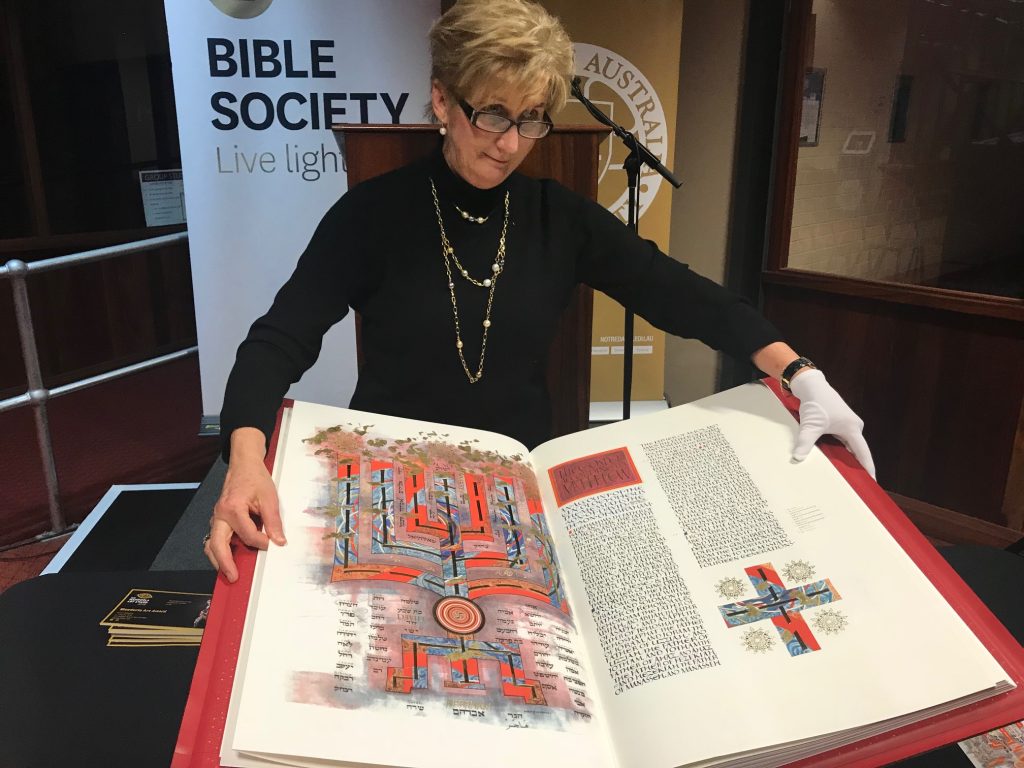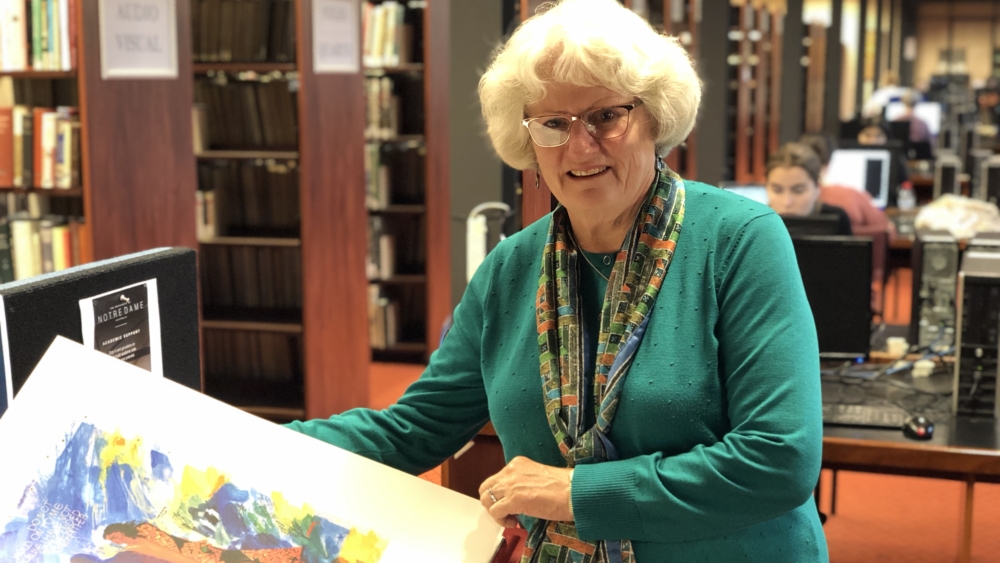Magnificent handwritten illuminated Bible delights the mind and senses
Be stunned in Perth by a modern masterpiece of sacred art
When Angela McCarthy turns the page to the first chapter of Matthew’s Gospel in the giant handwritten, illuminated St John’s Bible, I let out an involuntary gasp of surprise and delight.
Wow! “That’s how everyone reacts.”
“Wow!” I breathe, in response to the glorious illustration of the genealogy of Jesus. Depicted are the male and female names from Abraham, Sarah and Hagar, in two branches in the shape of a Jewish menorah or the double helix of DNA.
“That’s how everyone reacts,” chuckles the senior lecturer in theology at Notre Dame University in Fremantle, Western Australia. One volume of the metre-high hand-scribed St John’s Bible is on loan to Notre Dame, as part of a Festival of Religious Art.
 As my eyes rove around the spectacular visual representation of the forebears of Jesus, extravagantly hand burnished with gold to show the presence of God, I realise what an extraordinary project this is. Even though it is the first handwritten illuminated Bible since the invention of the printing press 500 years ago – entailing the rediscovery of long vanished skills – it could only have been created in the 20th century.
As my eyes rove around the spectacular visual representation of the forebears of Jesus, extravagantly hand burnished with gold to show the presence of God, I realise what an extraordinary project this is. Even though it is the first handwritten illuminated Bible since the invention of the printing press 500 years ago – entailing the rediscovery of long vanished skills – it could only have been created in the 20th century.
“The beautiful use of the double helix, the DNA, this is Jesus’s DNA, and this is our faith DNA, this is where it comes from,” comments McCarthy.
Contemporary references in other volumes of this Bible include magnified images of viruses, of satellite photos of the Ganges Delta, and photos from the Hubble Telescope to depict creation.
The dramatic ink drawing of the genealogy of Jesus is just one of 165 major illustrations in the seven volumes of the complete Bible, created by six artists under the direction of Donald Jackson, Senior Scribe to the Queen (who is also known as the best calligrapher in the world).
The Welsh artist had a dream from childhood to create a hand-scribed, hand-illuminated Bible like the ones he saw in the British Museum. In 1995 he presented his dream to Father Eric Hollas, a monk at St John’s Monastery in Minnesota, USA, who was looking for a way to celebrate the monastery’s 150th anniversary.
“Donald Jackson has a conversation with the right monk at the right time about what can we do for the new millennium,” McCarthy tells Eternity in Notre Dame University’s St Teresa’s Library, where she is showing me this work.
“So here’s a need for celebration and a calligrapher with the skills and the desire to do it.”
“‘Scribing a Bible for Dummies’ didn’t exist” – Angela McCarthy
In keeping with the rich Catholic tradition of sacred art, a part of the St John’s Bible is on display at the university as part of a Festival of Religious Art. The festival also displays historic Bibles and the past winners of the Mandorla Award.
Bible Society Australia has sponsored the Saint John’s Bible and the Festival of Religious Art, and BSA’s CEO Greg Clarke attended the launch last Friday, along with Father Eric Hollas.
What visitors will see at the university is not the original St John’s Bible – which is on display at the St John’s Gallery in Minnesota – but a single volume from one of 299 Heritage Editions that have been created to allow people all over the world to see it, touch it, read it and even buy it.
So far, 100 of the 299 sets have been sold at $165,000 each including two in Australia. The University of Notre Dame hopes to raise the funds to buy one.
“The original is done on calf skin vellum, and the way the pages turn, the feel of it, the sense of it, is extraordinarily beautiful because it’s organic,” explains McCarthy.
“One of the things Donald Jackson wanted [for the Heritage Edition] was a paper that felt like, looked like, didn’t smell like but was something like the vellum, so he chose cotton paper. It’s organic and that makes a big difference. The way that it folds, the way that it turns has a beautiful organic, gentle feel to it.
“This volume in front of you is about $25,000 which is a reasonably pricey book.”
McCarthy says the St John’s Bible project, which cost a total of $11.7 million (for which the major donor was Target), presented many technical challenges.
“There’s no handbook because when the printing press happened suddenly there was no more scribing because the printing press took over. So they were trying to recreate this without having a blueprint, without having a how-to-do-it manual. A ‘Scribing a Bible for Dummies’ didn’t exist, so they’re having to make all these decisions, such as incorporating quite obviously different scribe styles. They also discarded a lot of the vellum sheets they were given to examine because they were really conscious of a very good style.”
“This is engaging the imagination of … a whole range of other people because it is so beautiful.” – Angela McCarthy
She said the project was so huge that Donald Jackson was concerned he might not be around to finish it, so he put together a team of scribes, artists and an iconographer to assist him. In the end, the team created 165 major illustrations and 1150 pages of handwritten text in the original Bible by 2011.
The visionary project, which Newsweek dubbed America’s Book of Kells (an illuminated manuscript in Dublin), so captured the public imagination that when the St John’s Bible was exhibited in the Library of Congress in Washington, the exhibition was extended twice.
“So this is engaging the imagination of not just your regular Christian intensives but a whole range of other people because it is so beautiful,” says McCarthy.
The idea of creating a Heritage Edition came up part way through the project because “if they only had the original in Minnesota, there is no way of disseminating it around the world except digitally – and digital does not give you the sense of it.”
“It isn’t the same as touching it. You can’t feel the detail because it’s a sensory experience. The texture of this paper is really exquisite.”
“That’s how the word of God is proclaimed.” – Angela McCarthy
For me, the diversity of art styles and the intensity of the imagery make viewing this Bible memorable and moving. For McCarthy, viewing this Bible takes her back to her childhood love of Bible illustrations. As a Catholic, she wasn’t allowed to read the Bible but would hold up family dinners by poring over the illustrations in Bible stories.
Because of the stylised text, which is in the New Revised Standard Version, the Bible is hard to read but McCarthy believes this aids meditation.
“You stop and you read it slowly and then you read it again and then you get the image in your mind and then as that unfolds you read it slowly. That’s how the word of God is proclaimed.”


